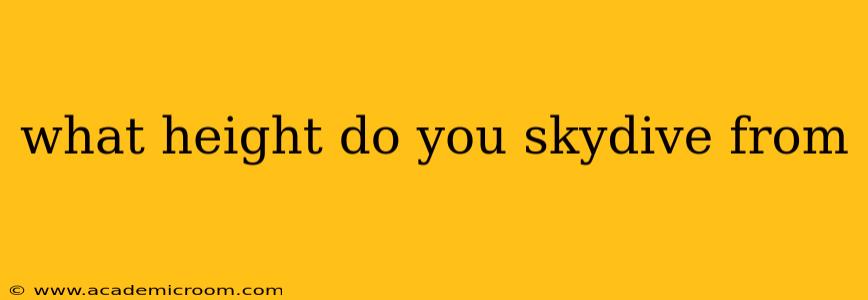What Height Do You Skydive From?
The height from which you skydive isn't a single, universally fixed number. It depends on several factors, including the type of jump, the experience level of the skydiver, and the specific dropzone regulations. However, there are common ranges and some typical scenarios to consider.
What is the standard skydiving altitude?
The most common altitude for recreational skydiving is 10,000 feet (approximately 3,000 meters) above ground level (AGL). This provides ample time for freefall – usually around 60 seconds – before deploying the parachute. This altitude offers a good balance between freefall time and safety margins.
What are some other common skydiving altitudes?
While 10,000 feet is the standard, you'll find variations:
-
Higher Altitudes (12,000-14,000 feet or higher): These altitudes are often used for advanced skydiving disciplines like canopy piloting competitions or large group formations (known as formations skydiving). The extended freefall time allows for more complex maneuvers and formations. These higher altitudes often require additional training and certifications.
-
Lower Altitudes (8,000-9,000 feet): Some dropzones, particularly those with stricter regulations or limited airspace, may operate at slightly lower altitudes. This reduces freefall time but maintains a safe jump. Tandem jumps (where a student is attached to an experienced instructor) may also sometimes be performed from lower altitudes to minimize risk.
Why isn't there a single, universal skydiving altitude?
The variability in altitude stems from several factors:
-
Air Density: Air density varies with altitude, affecting freefall speed and parachute deployment. Higher altitudes have thinner air, leading to faster freefall.
-
Safety Regulations: Different countries and dropzones have their own safety regulations that may dictate minimum and maximum jump altitudes.
-
Experience Level: Beginner skydivers typically jump from lower altitudes than experienced jumpers. This is a safety precaution.
-
Jump Type: Different skydiving disciplines, like freefly or wingsuit flying, require varying altitudes to accommodate their specific needs.
What altitude is used for tandem skydives?
Tandem skydives, where a student is harnessed to an instructor, are usually performed from an altitude between 10,000 and 14,000 feet. The higher altitude provides a longer freefall experience. However, the specific altitude will depend on the dropzone and prevailing conditions.
Are there any risks associated with skydiving at different altitudes?
Regardless of the altitude, skydiving inherently carries risk. Higher altitudes generally mean longer freefalls, increasing the potential for errors and the severity of consequences if something goes wrong. Proper training and adherence to safety protocols are crucial at all altitudes.
In conclusion, while 10,000 feet is a common and widely accepted altitude for recreational skydiving, the actual height varies based on many factors. Always defer to the specific regulations and instructions of the licensed dropzone and your instructors before making a skydive.
